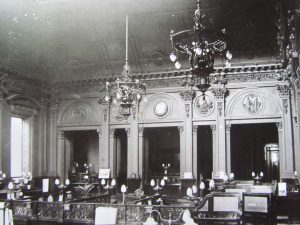January 1855: The Union Bank Telling Room
As mentioned elsewhere, a day-by-day search of Glasgow’s newspapers and journals can provide information on so many
different aspects of the city’s cultural history. In the nineteenth century, numerous publications recorded details of art
collectors, art sales, exhibitions and the art trade, as well as the construction of new buildings, among other subjects.
When I reached the 1855 newspapers, I was so pleased to find several articles about the Union Bank of Scotland’s
new telling-room (often spelt without the hyphen). The description perfectly matched many of the details, which
were recorded in the photograph at the Mitchell Library.
An article on page five of The Glasgow Chronicle, on Wednesday the 31st of January, 1855, reads:
“THE UNION BANK TELLING ROOM.
We had an opportunity the other day of viewing the magnificent telling-room of the Union Bank of Scotland, which has
for some time been under reconstruction, and is now nearly completed. For beauty of design and tasteful execution we
believe it cannot be equalled by any banking establishment in the kingdom. The style is Roman Corinthian of the Revival
period, and the fine coved ceiling rising off the entablature finishes in a dome 26 feet in diameter. The stained glass in the
dome represents emblems of the arts and sciences. In all coved ceilings, the angle line is known to artists to be disagreeable,
and various methods have been adopted to get quit of that line by ornamentation. In the present case, Mr Salmon of this city
has been eminently successful by the introduction of four figures, the workmanship of Mr Thomas of London, representing
the four quarters of the world. The ceiling is highly decorated, and the painting chaste and quiet, with only as much gilding
as exhibits the hand of art. Four circular panels in the north wall are to be filled with subjects in painted glass, representing
the armorial bearings of Glasgow, Aberdeen, Greenock, and Paisley, supported by allegorical figures, and the clock is
ornamented by a beautiful bas relief by Mr Mossman, showing ‘Old Time’ oiling the wheels, whilst two thoughtless youths
are endeavouring to force Time’s progress. Corinthian pillars adorn the walls, and on the projections are bas relief figures
with festoons. In the south wall there is a triplet window of stained glass with full-length figures—Mr Patterson, the founder
of Scottish Banking, occupying the centre, and supported by portraits of Adam Smith and James Watt. The side windows
with relieved borders are in one sheet, and the largest, we are informed, that has been produced in the style. The glass
decorations are by Mr Ballantine, of Edinburgh. Immediately above the triplet window are three groups representing
agriculture and commerce supporting the arts. These are also by Mr Thomas of London, and the introduction of a gold
ground behind has a beautiful effect. We are not aware of any other example of bas relief sculpture in this country with gold
back ground. The lower part of the walls are painted Siena marble, and the floor and entrance lobby are laid in caustic tyle [sic]
by Minton. This is the first introduction of that flooring in Glasgow, and the effect is very beautiful. The counter top is made
of a single plank of teak, and measures about 32 feet. The counter front and enclosure is of fir, carved, and the bronze railing,
furnished by Messrs McConnel, is of tasteful design. The modelling of all the ornaments, with the exception of the statuary, is
by Mr James Steele, of Glasgow; and the plaster work is perhaps the finest that has been produced in Glasgow. The apartment
measures 64 feet by 50 feet, and presents a triumph in the art of design and skill in execution such as Glasgow may well be
proud of.”
Reproduced courtesy of The Mitchell Library, Glasgow.
The British Newspaper Archive.
George Fairfull-Smith, August 2023.

